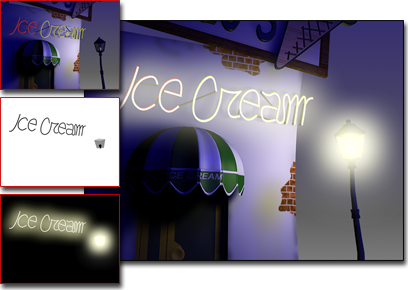G-Buffer (graphics buffer) is a type of rendering channel. Two file formats output by 3ds Max, RLA and RPF, can incorporate masks that are based on graphics buffer (G-Buffer) channels instead of the more widely used RGB and alpha channels. In addition, some kinds of Filter and Layer events as well as certain rendering effects can post-process objects or materials designated by the G-Buffer.

Main image: G-buffer used to apply a glow to lighting in a scene
Upper left: The same scene with no glow applied
Middle left: Objects selected using the G-buffer
Lower left: Glow applied to the G-buffer objects
You can set two kinds of these channels in the scene to identify and group objects or materials for a particular post-processing effect.
- You set an Object ID to identify that object to receive a particular rendering or post-processing effect or file mask, or to receive a particular map when using the Multi/Sub-Map shader.
- You set a material's Material ID Channel value to identify that material to receive a particular post-processing effect.
You create object-specific or material-specific post-processing by following this general procedure:
- Assign a particular Object Channel ID or Material ID Channel to the objects or the materials you want to be post-processed or affected by rendering effects.
- In the Image Filter or Image Layer event or in each rendering effect's Options tab, choose the channel ID that associates the event with the ID value you assigned in the scene.
- When you render the scene or execute the Video Post queue, 3ds Max singles out objects or materials that have the designated ID, and performs its post-processing only on those objects or materials.
- Glow lens effect (rendering effect)
- Ring lens effect (rendering effect)
- Lens effects Focus filter (Video Post)